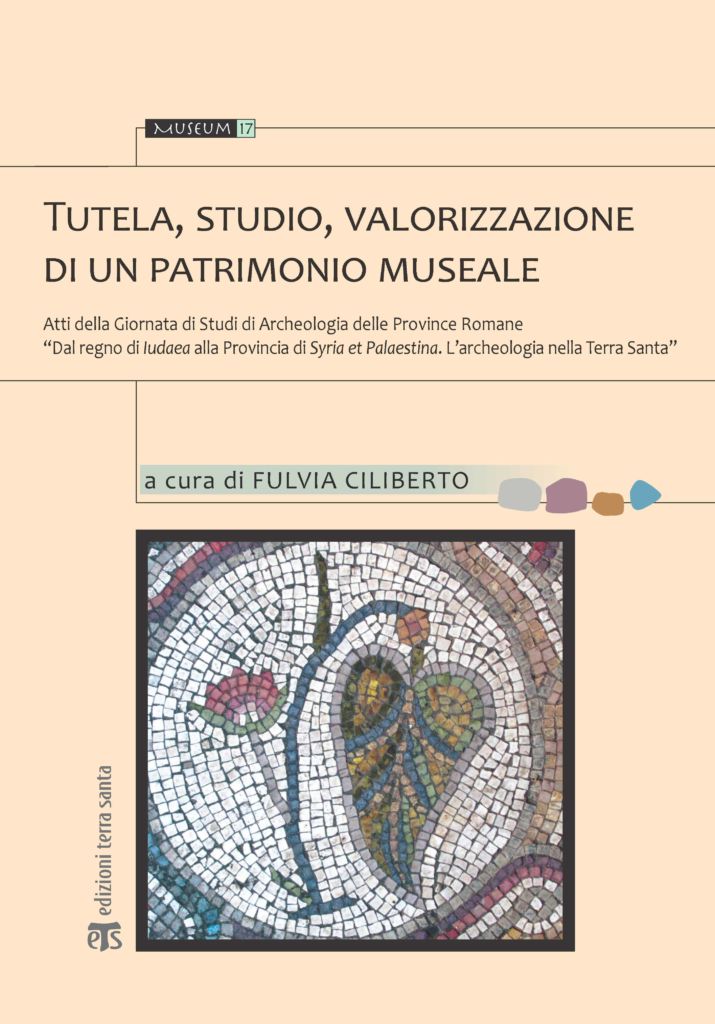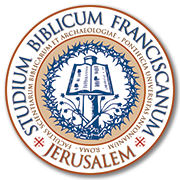
Fulvia Ciliberto (a cura di), Tutela, studio, valorizzazione di un patrimonio museale (Museum 17), Milano 2013
Atti della giornata di studi "Dal regno di Iudaea alla Provincia di Syria et Palaestina. L'archeologia nella Terra Santa", Isernia, 6 Aprile 2011
→ Scheda nel sito delle Edizioni Terra Santa
Sono qui raccolte le relazioni tenute durante una giornata di studio dedicata all’Archeologia delle Province Romane, e in particolare alla Provincia di Syria et Palaestina (poi Palaestina I, Palaestina II e Palaestina Salutaris), svoltasi il 6 aprile 2011 ad Isernia, presso la sede del Corso di Laurea in Lettere e Beni Culturali dell'Università degli Studi del Molise.
L'iniziativa, che ha potuto godere del sostegno finanziario del Dipartimento di Scienze Umane Storiche e Sociali, è nata dal desiderio di far conoscere il “Progetto di conservazione e valorizzazione del patrimonio culturale della Custodia di Terra Santa”, avviato nel 2009 dall’Associazione di Terra Santa (ATS), e al quale collaboro per quel che concerne i Beni Archeologici. L’intento è stato quello di avvicinare gli studenti a un ambito del lavoro archeologico meno familiare, e di condividere con i colleghi dell’Università molisana e gli ospiti di altre sedi universitarie, italiane e straniere, i primi risultati di un lavoro ancora lungo, ma promettente.
La giornata si è articolata in tre momenti: ha aperto i lavori un’interessante lezione di Padre Eugenio Alliata sull’attività svolta in Terra Santa dalla scuola archeologica dello Studium Biblicum Franciscanum, dagli inizi, alla fine del XIX secolo, fino alle più recenti scoperte. Ha fatto seguito la prima relazione è stata dedicata alla nascita ed allo sviluppo del “Progetto di inventariazione e catalogazione del patrimonio culturale della Custodia di Terra Santa” e alla presentazione degli obiettivi finora raggiunti, grazie alle nuove tecnologie digitali impiegate (Elisabetta Bruno). Infine, sono stati presentati -come esemplificativi- due casi, che mettono ben in evidenza tutta l’utilità, per la ricerca scientifica, per la salvaguardia e per la valorizzazione del patrimonio culturale, di un lavoro, quello della catalogazione, solo all’apparenza arido e ripetitivo. Nel primo caso, è stata proposta una rilettura di un frammento di sarcofago decorato a rilievo con tabella iscritta, giunto a Gerusalemme nella seconda metà dell’Ottocento da Beirut, e peculiare sia per la decorazione che per l’iscrizione (Fulvia Ciliberto - Cecilia Ricci); nel secondo, si rende noto l’avvenuto recupero dei dati di provenienza di un gruppo di lacerti di tessellato policromo, conservati presso il Museo Archeologico Privato dello Studium Biblicum Franciscanum, che ha permesso di attribuirli con certezza al loro contesto originario [il Santuario del Dominus Flevit], dove si conserva ancora gran parte della pavimentazione, della quale si avanza una prima proposta di datazione (Daniela Massara).
(Dalla “Premessa” della curatrice del volume, p. 7)
Abstracts
1. Elisabetta Bruno, “Conservazione e valorizzazione del patrimonio culturale della Custodia di Terra Santa. L’ausilio delle nuove tecnologie digitali”
Within the purview promoted by the Custody of the Holy Land for the conservation and valorisation of its cultural heritage, an organic and systematic documentation process was initiated. Awareness of the importance and value of historical sources (whether of documentary, archaeological or iconographic nature) and at the same time the risk of their physical degradation has raised the urgency of promoting a census, with cataloguing and digital recording. From October 2009 to date, over 4000 archaeological finds and 750 works of art have been catalogued in the Museum of the SBF. More then 4000 photographs have been indexed and 20500 digitalized. These results represent only a small step in a process which is still long to go, but the setting, the methodologies and the technical and scientific expertise involved ensure a gradual and systematic development of the documentation process. The cataloguing and digitalization will be used as a tool for a quick search and for an analytical information of the heritage belonging to the Custody of the Holy Land at the service of interested persons, as well as scholars and researchers.
2. Fulvia Ciliberto – Cecilia Ricci, “Da Beirut a Gerusalemme: un frammento di sarcofago a ghirlande con tabula iscritta”
The archaeological heritage in the Private Museum of the Studium Biblicum Franciscanum includes a wide variety of unique Roman finds: among them a fragment of a sarcophagus with garlands and carved inscription tablet stands out for its distinctive features. The sarcophagus comes from the city of Beyruth or its neighbouring areas, and reached Jerusalem in the second half of the XIX century. While the sarcophagus inscription was known since a long time, more recent is the study of its form and decorations, dating back to 1970 thanks to the contribution of Father Alejandro Recio Veganzones. Developments in the sarcophagi’s research from the ‘70s to the present called for a re-examination of the piece, with a new interpretation and dating.
The sarcophagus’s tablet contains a short text in verse, an invitation to the deceased to take comfort in the fate without pain of his widow and children. In the text, personal or professional data don’t appear; it isn’t therefore possible to identify the recipient of the sarcophagus.
3. Daniela Massara, “Dal mosaico bizantino del monastero del Dominus Flevit (Gerusalemme) al Lapidarium della Flagellazione. Storia di un legame riscoperto”
The present research considers a group of fragments of polychrome tessellated mosaic floor, placed in no particular order and direction onto one of the external surfaces of the porch of the Private Archaeological Museum in the Studium Biblicum Franciscanum. Some of the fragments analysed are relevant to an area of the Oratory within the byzantine monastery Dominus Flevit located in Jerusalem, where most of the flooring is still available. The location and digitalisation of the photographic plates reproducing the images of the remains herein analysed before their removal, have made it possible to spot the original location of the now walled-in fragments. The floor has been severely damaged by the iconoclasm and the reconstruction attempts from the past to the present days. In view of plausible comparisons and the analysis of the decorations, the present work suggests the hypothesis that the mosaic dates back between the end of the VI and the beginning of the VII century A.D.


